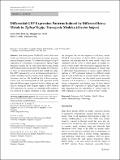| dc.contributor.author | Ng, Grace Hwee Boon | |
| dc.contributor.author | Xu, Hongyan | |
| dc.contributor.author | Pi, Na | |
| dc.contributor.author | Kelly, Barry C. | |
| dc.contributor.author | Gong, Zhiyuan | |
| dc.date.accessioned | 2016-10-06T20:33:02Z | |
| dc.date.available | 2016-10-06T20:33:02Z | |
| dc.date.issued | 2015-02 | |
| dc.date.submitted | 2014-10 | |
| dc.identifier.issn | 1436-2228 | |
| dc.identifier.issn | 1436-2236 | |
| dc.identifier.uri | http://hdl.handle.net/1721.1/104657 | |
| dc.description.abstract | Heat shock protein 70 (Hsp70) is one of the most widely used biomarker for monitoring environment perturbations in biological systems. To facilitate the analysis of hsp70 expression as a biomarker, we generated a Tg(hsp70:gfp) transgenic medaka line in which green fluorescence protein (GFP) reporter gene was driven by the medaka hsp70 promoter. Here, we characterized Tg(hsp70:gfp) medaka for inducible GFP expression by seven environment-relevant heavy metals, including mercury, arsenic, lead, cadmium, copper, chromium, and zinc. We found that four of them (mercury, arsenic, lead, and cadmium) induced GFP expression in multiple and different organs. In general, the liver, kidney, gut, and skin are among the most frequent organs to show induced GFP expression. In contrast, no detectable GFP induction was observed to copper, chromium, or zinc, indicating that the transgenic line was not responsive to all heavy metals. RT-qPCR determination of hsp70 mRNA showed similar induction and non-induction by these metals, which also correlated with the levels of metal uptake in medaka exposed to these metals. Our observations suggested that these heavy metals have different mechanisms of toxicity and/or differential bioaccumulation in various organs; different patterns of GFP expression induced by different metals may be used to determine or exclude metals in water samples tested. Furthermore, we also tested several non-metal toxicants such as bisphenol A, 2,3,7,8-tetrachlorodibenzo-p-dioxin, 4-introphenol, and lindane; none of them induced significant GFP expression in Tg(hsp70:gfp) medaka, further suggesting that the inducibility of Tg(hsp70:gfp) for GFP expression is specific to a subset of heavy metals. | en_US |
| dc.publisher | Springer US | en_US |
| dc.relation.isversionof | http://dx.doi.org/10.1007/s10126-015-9620-5 | en_US |
| dc.rights | Article is made available in accordance with the publisher's policy and may be subject to US copyright law. Please refer to the publisher's site for terms of use. | en_US |
| dc.source | Springer US | en_US |
| dc.title | Differential GFP Expression Patterns Induced by Different Heavy Metals in Tg(hsp70:gfp) Transgenic Medaka (Oryzias latipes) | en_US |
| dc.type | Article | en_US |
| dc.identifier.citation | Ng, Grace Hwee Boon et al. “Differential GFP Expression Patterns Induced by Different Heavy Metals in Tg(hsp70:gfp) Transgenic Medaka (Oryzias Latipes).” Marine Biotechnology 17.3 (2015): 317–327. | en_US |
| dc.contributor.department | Singapore-MIT Alliance in Research and Technology (SMART) | en_US |
| dc.contributor.mitauthor | Ng, Grace Hwee Boon | |
| dc.contributor.mitauthor | Gong, Zhiyuan | |
| dc.relation.journal | Marine Biotechnology | en_US |
| dc.eprint.version | Author's final manuscript | en_US |
| dc.type.uri | http://purl.org/eprint/type/JournalArticle | en_US |
| eprint.status | http://purl.org/eprint/status/PeerReviewed | en_US |
| dc.date.updated | 2016-08-18T15:41:18Z | |
| dc.language.rfc3066 | en | |
| dc.rights.holder | Springer Science+Business Media New York | |
| dspace.orderedauthors | Ng, Grace Hwee Boon; Xu, Hongyan; Pi, Na; Kelly, Barry C.; Gong, Zhiyuan | en_US |
| dspace.embargo.terms | N | en |
| mit.license | PUBLISHER_POLICY | en_US |
| mit.metadata.status | Complete | |
